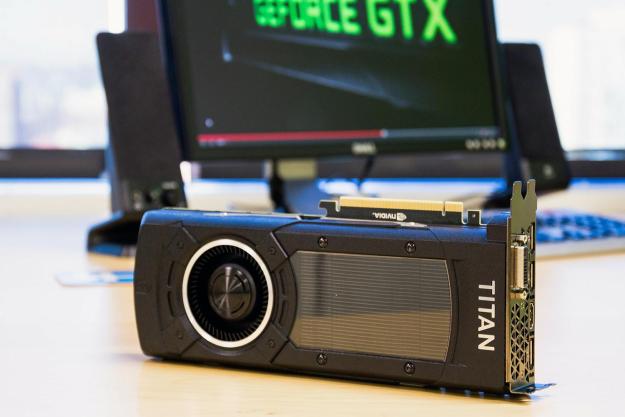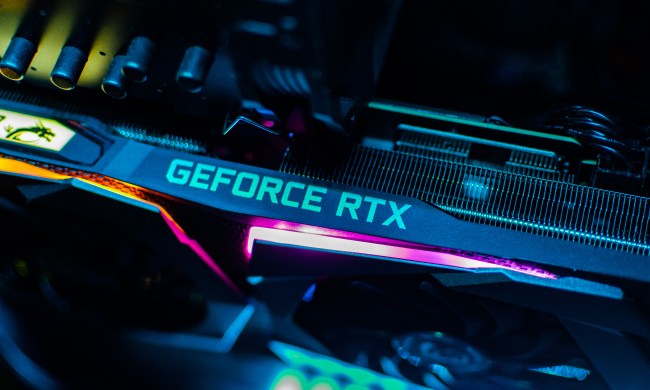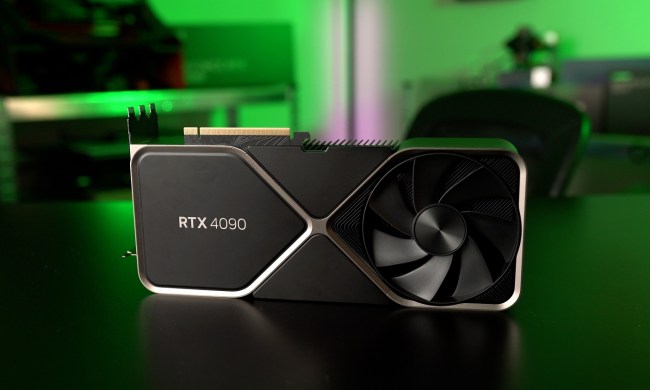
- Can handle games at 4K resolution
- Easily the quickest single-GPU video card
- No larger than GTX 980
- Attractive, high build quality
- Somewhat noisy at times
- Expensive
In February of 2013, Nvidia released an incredibly quick new card called the GTX Titan. Based on the company’s latest graphics architecture and packing over seven billion transistors, the Titan set a new bar in single-GPU video card performance. It also created a new category of ultra-premium graphics hardware with capabilities far beyond what’s normally available.
Hardware ages, though. What was new and exciting becomes old and outdated. The GTX 780’s release in May of 2013 made the Titan far less appealing because it offered similar performance at a much lower price. The Titan Black and dual-GPU Titan Z each hit new bars in benchmarks, but the increase in speed failed to keep pace with the increase in price, and the Titan series became little more than a novelty for gamers.
Now, though, Titan has a chance to regain relevance with the Titan X, the latest, greatest single-GPU video card from Nvidia. Like the original, it’s priced at $999 (affordable, by the brand’s standards). Is this a new high water mark in gaming performance, or is it another luxury card for people with money to burn?
Trailing edge
The original Titan was the first video card to offer Nvidia’s GK110, a version of the Kepler architecture for high-end cards. That made it unique at the time, and it remained so until the GTX 780 appeared about four months later.
The Titan X is less progressive. Instead of leading a new architecture, it uses the GM204 found in the already released GTX 980M. The roles have been reversed, in other words: The original Titan represented cutting-edge technology, but the Titan X is an evolution of what was previous hardware.
But what an evolution! With eight billion transistors spread across 3,072 CUDA cores clocked at 1,000MHz (with a Boost clock of 1,075), the chip in the Titan X is about a third larger than the GTX 980’s GPU and provides over a thousand additional cores. To handle this incredible rendering power, Nvidia has thrown in 12GB of GDDR5 RAM connected over a 384-bit bus, which adds up to 336GB/s of bandwidth. The GTX 980 has a third of the memory, at 4GB, and a slimmer 256-bit interface.
AMD’s quickest single-GPU video card, the Radeon R9 290X, comes closer to the Titan X in memory, but lags behind with 4GB of RAM over a 512-bit interface. That provides about 320GB/s of bandwidth, a bit less than the Titan X.
Surprisingly, the Titan X has limited support for double-precision math, a headline feature of the original Titan. Such calculations can be performed, but only at 1/32 of normal performance. In other words, the Titan X does not specifically target enterprise and research customers who need perfect data integrity, a departure from the past. This indicates Nvidia has designed the hardware with gamers as the focus, unlike the Titan Z, which was best for workstations.
Back in black
Aesthetically, the Titan X is a mere change of clothes. It ditches the silver gunmetal look of the 700 and 900 series cards, which began with the original Titan, in favor of a black exterior with chrome accents. All the functional components are the same, however. The card still uses a blower fan that throws air over a long array of copper fins wedged inside a metal case that’s 10.5 inches long. You’ll need both an 8-pin PCIe and 6-pin PCIe connector to power the Titan X, just like its predecessor.
While more powerful than the GTX 980, the Titan X is no larger.
Unlike the GTX 980, the Titan X does not include a metal back plate over the exposed PCB. This means the more expensive Titan doesn’t look as luxurious as its less expensive predecessor, but it’s still no slouch in build quality.
Port selection is robust, with three DisplayPort 1.2, one HDMI 2.0 and one DVI. This arrangement is geared towards modern displays, particularly 4K sets, as only the DVI port is limited to 2,560 x 1,440. The maximum supported resolution is 5,120 x 3,200 so the Titan X, unlike the first Titan, can handle Dell’s 5K monitor. However, while it has five ports, the card can only support four monitors at a time.
Warming up
The Titan X uses a cooler identical to the GTX 980, which is a bit surprising given how much larger the GPU is, and how much more power its specifications suggest it will draw. The latter has a thermal design power of 165 watts, while the former is 250 watts. That’s a significant increase, as can be expected from a chip with a third more transistors.
On the other hand, this same design was used to cool the similarly hot-headed GTX 780 Ti. As such, the Titan X isn’t too hot to handle, and at idle its power consumption comes in at 59 watts while it puts out 39.5 decibels of noise. These figures are roughly the same as the GTX 980 at idle.
Load is another story. The Titan X runs both hotter and louder than the GTX 980. We recorded a maximum power draw of 334 watts and maximum fan noise of 43 decibels. The GTX 980, in contrast, hit just 250 watts, and produced only 39.1 decibels of noise. Obviously the Titan X is louder and draws more power, but its results seem tolerable, even modest, given its capability.
All of these figures are based on our test rig, a Falcon Northwest Talon, not for the video card alone. That said, the Talon we use has no significant fan noise aside from the video card.
Redefining fast
Thank you to Origin for providing the GTX Titan X for testing. Check out our review of the Origin Millennium, a desktop with record-breaking performance.
No one ever doubted the Titan X would be the quickest single-GPU card yet produced. The latest, most expensive hardware is almost always the fastest. What makes a card great, however, is the ability to provide gameplay at a resolution or detail previously impossible.
To see how this shiny new card stacks up, broadly speaking, we first threw it into FutureMark’s 3DMark, a synthetic test that offers an excellent performance guideline.
These results show a strikingly significant gap between the GTX 980 and the Titan X, with the latter providing almost a 50 percent increase in performance.
Obviously, from a pure value standpoint, this still doesn’t make the latter the more compelling option, as it’s almost twice the price. Yet it does suggest the Titan X will be able provide a playable experience in situations the GTX 980 can’t handle.
It’s also a far more compelling result than the original Titan, which became largely irrelevant once the GTX 780 arrived. In most games and benchmarks, the gap between those cards was 10 to 15 percent. If the Titan X is as quick in games as 3DMark suggests, it’ll be an incredible victory.
Diablo 3
First on our roster is Blizzard’s Diablo 3, which is by far the least demanding title we test. It’s not much challenge for any current video card at 1080p, and certainly not the Titan X, which hit an average of 433 frames per second even at maximum detail.
4K resolution, though, is not a pushover. The GTX 960, the current mainstream value leader, can just barely average 60 FPS at maximum detail. Nvidia’s flagship, however, destroys the game, offering an average of 173 FPS. In fact, it was just shy of the mighty dual-GPU Titan Z, which averaged 186 FPS under the same conditions.
Civilization: Beyond Earth
No longer the most recent game with the Sid Meier name attached to it (that honor goes to the new Starships), this title is deceptively difficult for cards to handle in late-game scenarios because of the large number of units, improvements, and other details on-screen.
Again, 1080p provided no problem. Even at ultra detail, with anti-aliasing at the maximum setting, the game turned in an average of 158 frames per second. 4K was a more serious challenge, but the Titan X still cranked out an average of 74 FPS.
That does beat the Titan Z, which hit 67 frames per second, and almost beats the Falcon Northwest Mach V we reviewed with three GTX 980 graphics cards. That’s a very notable result, as it suggests that simply buying two GTX 980s (which cost slightly more than the Titan X) may not be the best choice in all games.
Battlefield 4
DICE’s epic first-person shooter remains demanding, though it’s no longer the most beautiful game around. At 1080p it’s easy for the Titan X to handle, of course, and cleared an average of 171 FPS even at ultra detail.
4K performance was more impressive, as the card averaged 61 FPS at ultra, just barely above the magic 60 FPS number PC gamers prefer. And, importantly, the minimum framerate never dipped below 54.
It’s also notable that once again, the Titan X beat the $3,000 Titan Z, which averaged 48 FPS. Even two GTX 980s aren’t as quick: They clear 57 FPS at the same settings.
Middle Earth: Shadows of Mordor
The DT Accessory Pack
Up your game and the get the most out of your gear with the following extras, hand-picked by our editors:
Acer XB280HK 28-inch 4K G-Sync monitor ($750)
Compliment the ultimate video card with a monitor that can do it justice and supports G-Sync, Nvidia’s frame synchronization technology.
Cable Matters DisplayPort cable ($10)
While HDMI 2.0 can do 4K, DisplayPort remains the most common method of relaying the resolution.
ASUS Z97-A LGA1150 motherboard ($150)
Aging systems may need an upgrade to take advantage of the Titan X. The Asus Z97-A is a great budget-friendly motherboard for the latest Intel processors.
Corsair CX750 Builder Series power supply ($85)
Need some extra juice to power the Titan X? This supply from Corsair can do the job at a reasonable price.
One of the best games of 2014, Middle Earth: Shadows of Mordor is a cross-platform title that can really put hardware to the test with its extreme texture resolution. We tested the game with the Ultra texture pack installed.
1080p was, once again, no real challenge. The game averaged 128 FPS even at ultra detail. 4K is where this game kills video cards, and it proved demanding enough to kick the average down to 53 FPS at ultra.
That’s proven very playable, even if it wasn’t quite at the ideal 60 FPS average. The result also absolutely spanked the Titan Z, which managed a mere 34 FPS. It even came in just a bit behind a tri-SLI GTX 980 setup, which averaged 65 FPS. That’s incredible given the Titan X has a single GPU inside.
Crysis 3
Even the mighty Crysis provided no problem for the Titan X at 1080p. The game averaged 65 FPS even at maximum system specification with very high textures and 8x MSAA turned on. This is a major improvement over the GTX 980, which can only reach 43 FPS at the same settings.
Ramping up to 4K severely increased the load, and in the end this proved the only game the Titan X can’t handle at
However, for the sake of experimentation, we turned off anti-aliasing. This had minimal impact on image quality because of 4K’s high pixel density, and it bumped the average up to a playable 30 FPS. You can play Crysis at 4K and near-maximum detail on the Titan X if you’re willing to tolerate barely noticeable jaggies.
Conclusion
Nvidia’s Titan X is indisputably the most impressive card to ever come with the Titan name attached. The original card was an attractive novelty for gamers, but only made real sense to workstation users, and the Titan Black and Titan Z, both of which were gaming cards in name only, followed that example. The latter was a particularly poor value; there was virtually no reason to buy it instead of two GTX 780 Ti cards, which performed similarly at a third of the price.
At $999, this is still an expensive card, and it’s not the best overall value. You’ll enjoy more bang for your buck from a GTX 980, or 970, or almost any card that’s less than $600. Yet the Titan X provides a level of performance that is well beyond what any other single-GPU video card can obtain, and it’s the first of its kind that can play games at 4K resolution near maximum detail and still average 60 FPS.
Even the Titan X can’t every game at 4K with every option turned on, but it’s surprisingly close, and it’s a completely valid alternative to running two GTX 980s in SLI. In fact, it may be preferable, given that any problem with SLI (like a new game lacking support for the feature) can cripple your experience.
Obviously, not every gamer can buy this video card. It costs more than a PlayStation 4, Xbox One and Wii U combined. If you’re interested in the absolute best PC gaming experience possible, though, the Titan X is the card to buy.
Highs:
- Can handle games at 4K resolution
- Easily the quickest single-GPU video card
- No larger than GTX 980
- Attractive, high build quality
Lows:
- Somewhat noisy at times
- Expensive









